As construction 3D printing matures and takes hold across the globe, building material makers are looking closer at this new market. Currently, many 3D printed building projects are made with a concrete-like material that will cure faster than traditional options, but the construction industry is demanding that they be able to 3D print with existing cheaper materials.
Today, more 3D construction companies are developing their own cement-based mortar that uses local aggregates, off-the-shelf Portland cement, and a mix of low-cost commercially available additives.
Let’s take a closer look at the state of additive manufacturing of cementitious materials also known as 3D printing concrete and mortar.
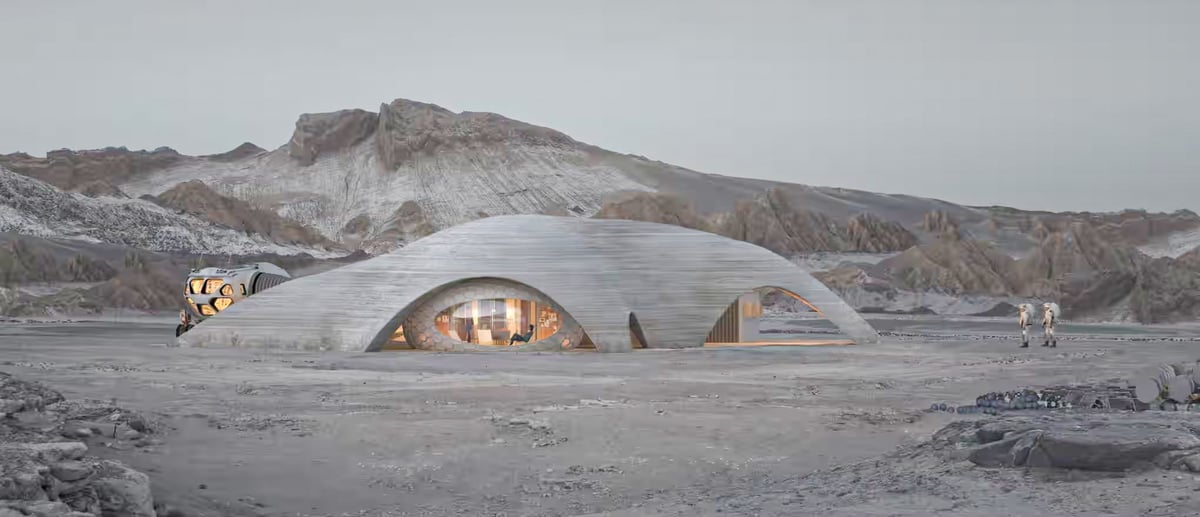
What is Concrete 3D Printing?
3D printing does not follow the conventional processes of laying bricks. Instead “layered construction” has become a completely new alternative technology in the building industry that reduces manpower, waste, and formwork while delivering increased productivity and geometric freedom.
Plus, construction sites are changing. Instead of building work being carried out entirely on-site, structural modules are increasingly pre-fabricated under industrial and automated conditions and assembled on-site, saving time and money, and enabling construction progress in harsh weather.
3D concrete printing (3DCP) technology is in use today for buildings, homes, architectural features, and construction projects from wells to walls. Proponents say it has the potential to significantly disrupt the entire construction industry if it can get over a few hurdles first.
Here, we’ll take a look at how companies are 3D printing with concrete (mortar, soil, and recycled products) today, what 3D printers they’re using, and what materials make it possible. You’ll learn about the basics and benefits of 3D concrete printing and what advantages it can offer over traditional construction techniques.
How to 3D Print With Concrete
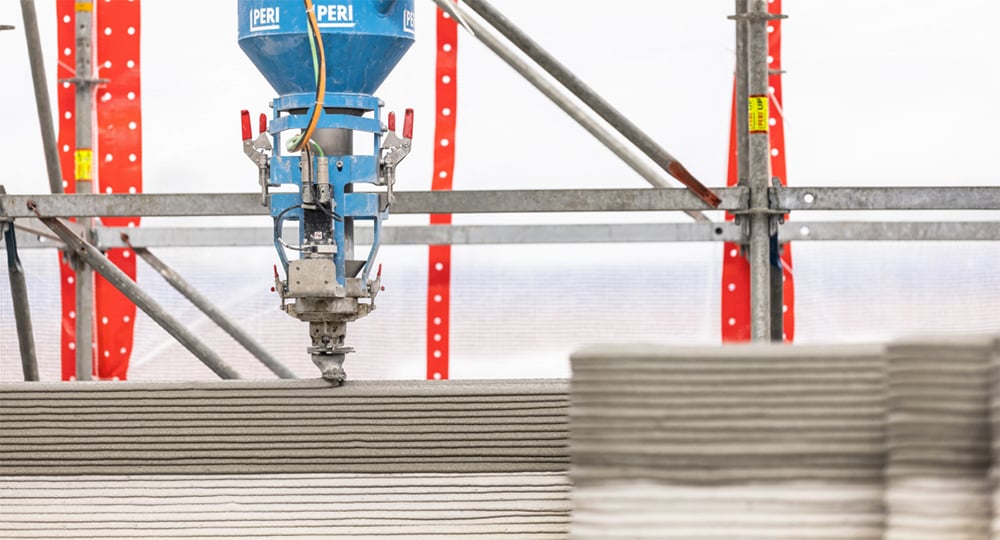
3D concrete printing uses extremely large-scale 3D printers, often measuring 30 feet in height and length to extrude concrete from a nozzle. These machines generally come either as gantry or robotic arm systems.
Whatever the printer’s configuration, practically all of them continuously extrude a dough-like concrete material that’s laid down in layers to create the desired building element.
Despite being called 3D concrete printing, the material is not always concrete in the strictest definition of the word.
Construction companies can 3D print with types of mortar, plastic and recycled plastic, and local natural materials, including moon rock and mars dust, along with sand, metal, and clay. In fact, the versatility of the technology is opening up new opportunities for more sustainable building, using local materials, waste materials, and recycled materials.
Traditional concrete is usually unsuitable for 3D printing because it would clog the printer nozzle and not adhere properly to the previous layers (see more in our section on materials). Many of the available materials today are unique and some are patented, making successful 3D concrete printing just as much about the material as it is about the printer.
In 2021 Mexican cement giant Cemex devised a method of using conventional ready-mix concrete during the 3D-printing process by adding a substance called D.fab, which turns concrete into a malleable material.
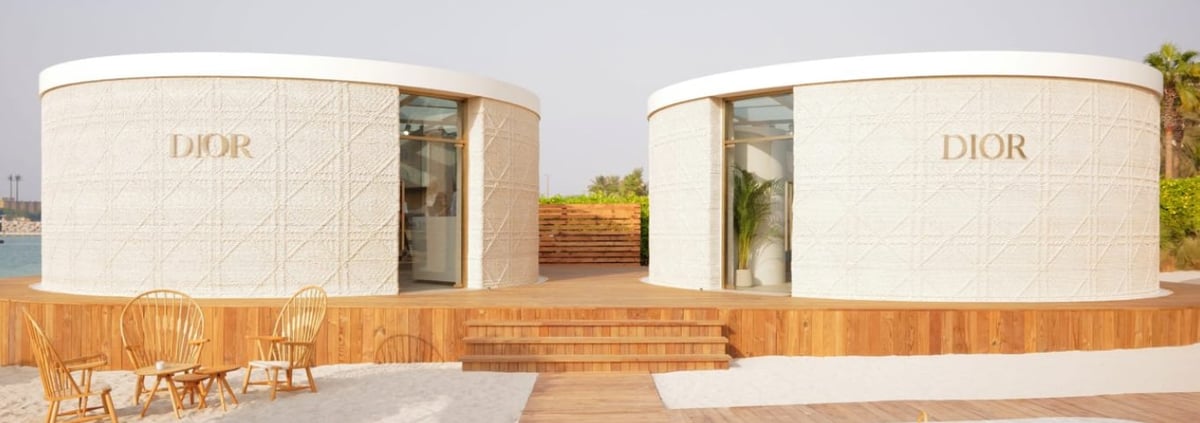
3D Printable Concrete Materials
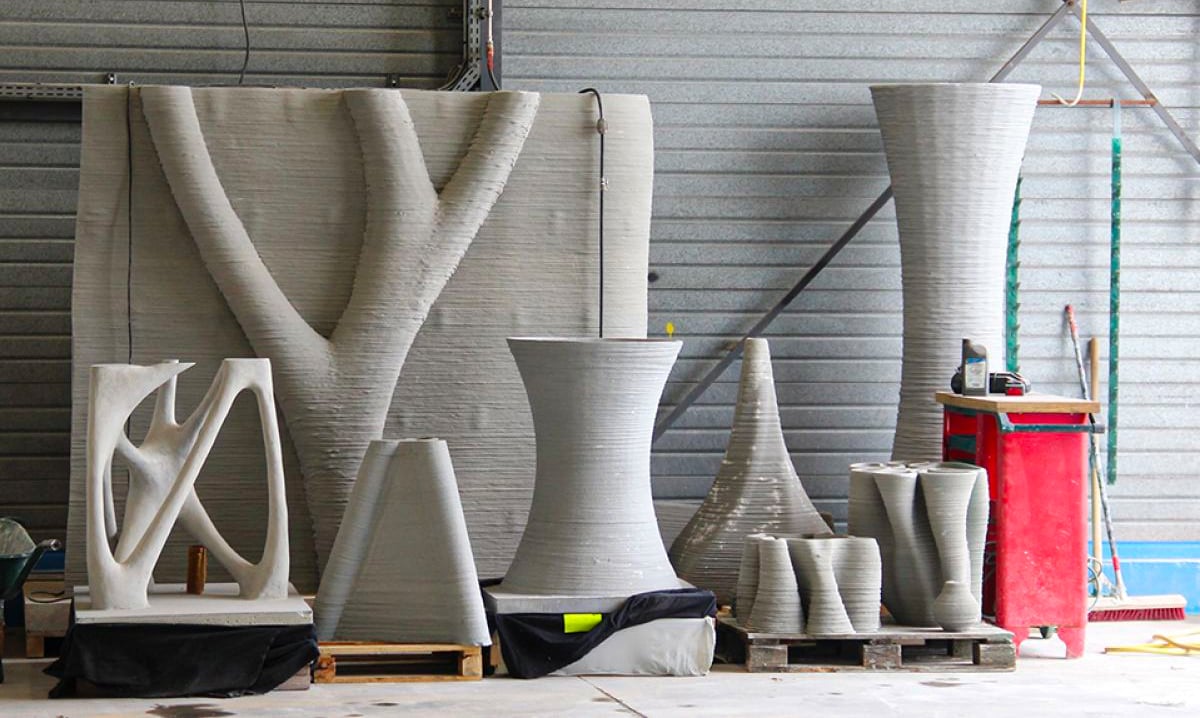
Most often, 3D printable concrete is a cement-based mixture of several materials, including super-plasticizers that remove water from the mix for faster drying and fibrous materials for improved strength. The materials are more like mortar. Providing similar functionality to concrete but with higher printability and sometimes better physical properties, the blends can be formulated for a specific purpose, such as printing walls for housing or for creating decorative architectural elements.
All 3D printable materials must have extrudability and shape retention. Most construction 3D printer manufacturers create their own proprietary material blends that have been optimized for their 3D printers (or for those of their immediate partners). Some examples of proprietary material blends include Icon’s Lavacrete and CyBe’s CyBe Mortar.
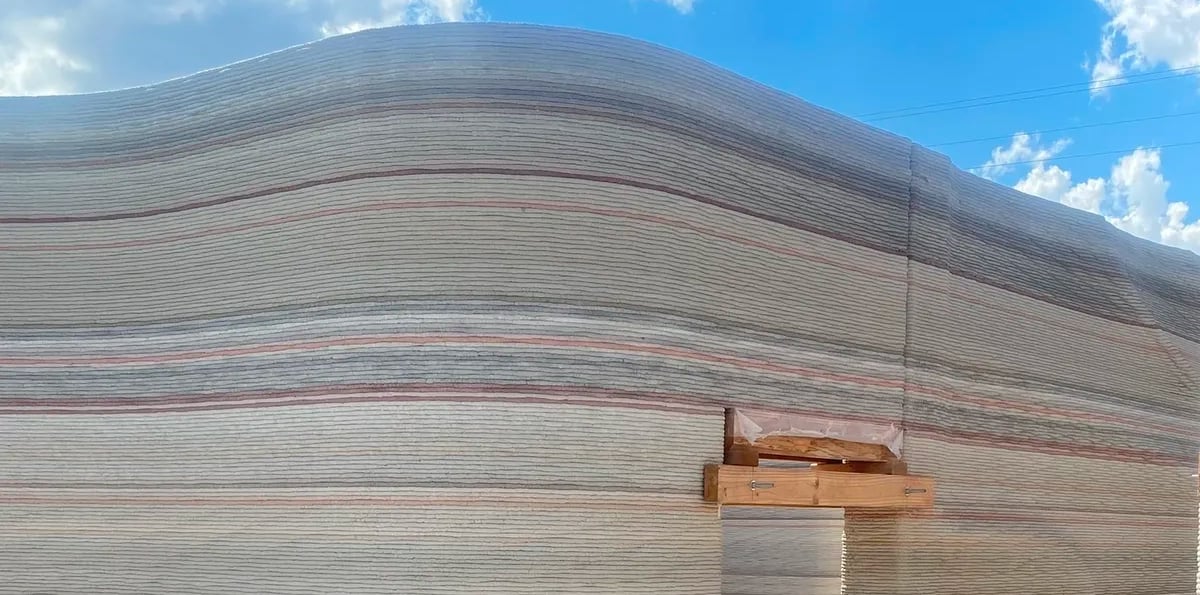
At present, these mortars are typically more expensive than standard construction cement, but that could change soon. Mexican cement company Cemex and the German University of Technology in Oman, along with printer maker Cobod, recently 3D printed a test building using standard concrete.
“While we have been happy to help cement and concrete manufacturers develop dry-mix 3D printable mortars, we have also insisted on a solution using real concrete made from local available materials, which will be needed for the mass application of our technology,” says Henrik Lund-Nielsen, Cobod’s founder.

There are some basic features that set 3D printable concrete materials apart from one another. One factor is drying time. There are materials, such as those by construction 3D printer companies Mighty Buildings and Icon, that are cured using UV light. These kinds of materials cure almost instantly and can be printed horizontally without supports.
Other 3D printer manufacturers, such as WASP, have formulated their building materials to be sourced locally, such as local earth and clay. Local material cuts down on costs, making 3D printable concrete a far cheaper option compared to traditional concrete, especially in developing nations.
Although still in the research phase, 3D printing with recycled materials, such as waste concrete from demolished buildings, is also a central eco-friendly selling point of the technology.
Several companies have entered the 3D printable concrete market with their own products. As we’ve already mentioned, many of the materials are proprietary and designed to work with the specific company’s own printers.
That said, others make more universal materials that works with different printers, with some even formulating their materials blends separately for each project. Here we take a closer look at some of the leading material producers in the field and what they have to offer.

CyBe
The Dutch additive construction company CyBe has on offer its CyBe Mortar. The material has been developed specifically for concrete 3D printing with CyBe printers.
CyBe Mortar is a non-metallic, low-chloride, and low-sulfate material that’s suitable for all environments, the manufacturer says. It sets in only three minutes and achieves structural strength in an hour, providing high durability and little shrinkage.
The material can be used in architectural, structural, industrial, and design applications. CyBe says it will also partner with companies to produce CyBe Mortar from locally available materials, cutting shipping costs.
When used with CyBe printers, the material can be deposited at a maximum speed of 600mm/s at a minimum layer height of 1cm and a maximum of 5cm. The company says CyBe Mortar cuts CO2 emissions by 32% when compared to traditional Portland cement.

Heidelberg Materials
German building material firm Heidelberg’s i.tech 3D has already cropped up with two projects we highlighted earlier. It was used in both Germany’s first 3D printed residential building and apartment building.
The i.tech 3D material was developed in Italy by Heidelberg’s subsidiary Italcementi. Formulated specifically for 3D printing, the versatile material isn’t tied to one particular machine and can be used with various types of 3D printers. Heidelberg says the material uses a “CO₂-optimised binder” with a carbon footprint around 55% lower than that of classic Portland cement.
The company says i.tech 3D concrete is 100% recyclable, and enables up to 70% less material usage.
Its proprietary formulation contains a mix of mineral components and additives that provide high pumpability and good extrusion properties. The material forms a strong bond with previous layers due to the fresh-on-fresh printing it enables, says HeidelbergCement.
The i.tech 3D material is particularly suitable for printing straight or curved finished parts and components, in addition to weight-bearing elements. The company says i.tech 3D’s formulation can be altered for different printing processes and conditions, allowing for greater productivity and design freedom.
Icon
Like i.tech 3D, Icon’s Lavacrete has already been mentioned in this article. This proprietary Portland cement-based blend is designed to work specifically with Icon’s Vulcan II printer.
As the company says, the exact formulation is a closely guarded secret, but Lavacrete can be made locally from easily sourced raw materials. It has a compressive strength of 6,000 psi – above that of conventional building materials – and it can withstand harsh and extreme weather conditions.
Lavacrete doesn’t require the cladding, framing, and sheetrock used in traditional construction, which lowers costs. The material has been formulated to have a good thermal envelope, providing insulation and comfort for the home.
The specific blend of material and additives in Lavacrete can be customized for each project and location with Icon’s Magma delivery system. The Magma system automatically mixes Lavacrete, additives, and water and supplies the ready-to-print mix to the Vulcan printer at the specified temperature, humidity, and speed.

LafargeHolcim
Unlike the other companies highlighted here, Swiss LafargeHolcim doesn’t produce a single named material. Instead, the company partners with construction companies on various projects, providing individually formulated 3D printable concrete mixes.
For example, LafargeHolcim has provided a printable white cement mixture for XtreeE, which has been used in various architectural and art projects. The company is also working with COBOD and GE Energy to develop a tailor-made concrete mixture for 3D printing bases for wind turbines.
That said, in June 2020, LafargeHolcim released Tector 3D Build, its first dry mortar material range for 3D printing. Made from cementitious materials and natural hydraulic lime, the material is capable of reaching very high print speeds, the company says.
Tector 3D Build is suitable for both residential and infrastructure printing projects. Unlike some 3D printable cement materials, it can be printed vertically, allowing facades and decorations to be printed directly onto the wall.

CEMEX
Mexican cement giant Cemex introduced a proprietary admixtures family called D.fab in 2021, which transforms conventional concrete into a versatile material that can be efficiently tailored for 3D printing construction.
Working with Danish 3D printer maker Cobod, this admixture innovation produces a more fluid and malleable concrete that facilitates the pouring process for 3D printing applications. Cobod’s printers and expertise, in combination with the admixtures, make it possible for the concrete to gain shape instantaneously. Cobod applied the new solution for the first time in a suburb of Luanda, the capital of Angola, where homebuilder Power2Build used it to construct Angola’s first 3D printed concrete house.

WinSun
China’s WinSun primarily serves the Asia-Pacific market – which is one of the fastest-growing regions for 3D printable concrete. The company produces several different materials that have been used in various projects throughout China and elsewhere.
WinSun’s Crazy Magic Stone (CMS) is an artificial stone material that is based on a modified cement mixture. The blend is further reinforced with enhanced glass fibers.
CMS provides a smooth finish that mimics natural stone colors and textures while providing five to 10 times higher mechanical strength than natural stone. The company says that the material has been used in more than 100 projects to print interior and exterior walls, floors, and roofs.
WinSun also produces the Special Reinforced Concrete (SRC) materials, which was developed to overcome the limitations of the earlier glass-fiber-reinforced gypsum material. SRC can be implemented to create complex internal and external architectural elements and decorations.
The fiber-reinforced material provides high strength and durability. WinSun says the exact SRC mix can be customized to each project’s specific needs.
Advantages of 3D Printing Concrete
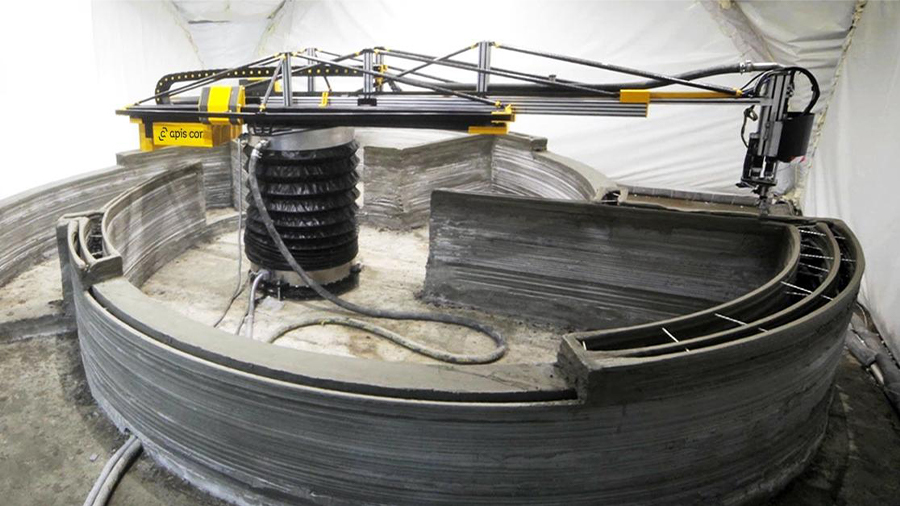
3D concrete printing for construction has advanced rapidly over the past five years, with innovation in robotics, material science, software, and 3D building design methodology. But why is that? What does it offer in comparison to traditional building methods?
Simply put, 3D printing has the potential to upend construction in terms of speed, cost efficiency, and productivity. However, it’s not quite there yet. There’s no evidence that the homes and buildings completed to date were done so for significantly less than what traditional manufacturing would have cost. Builders do say, however, that they spend less on materials when they 3D print and the parts of the homes that are 3D printed were completed far faster than if those parts were made of brick or wood frame. There are also savings on labor, and a concrete home or building has the potential to stay cooler in summer, hotter in winter, and withstand extreme weather events, such as hurricanes.
There have been dozens of home and building 3D printed across the glove, and of the 3D printing construction projects planned in 2023, most are multi-house developments or entire neighborhoods, indicating that with volume, the technology may eclipse the cost and speed of traditional building methods.

The 3D printing construction market should reach a value of $1.5 billion by 2027, according to the latest estimates.
As the number of 3D printed houses, schools, offices, and places of worship grows, builders realize the promised benefits of the technology, namely:
- Lower materials consumption since wall structures can be topologically optimized and partially hollow
- Less waste, no need for large-scale concrete molds or formwork
- Faster building times when compared to laying bricks or concrete molding
- Greater degree of design freedom, able to produce geometries (curves, hollowness, etc.) traditional concrete molding can’t
- Higher productivity (it can print 24/7)
- Lower need for labor
Further developments in technology will push material consumption ever lower as better materials and printers will be able to create more complex and structurally sound geometries that aren’t currently possible.

However, the 3D concrete printing industry faces challenges it must overcome before widespread adoption is possible. These include:
- High initial investment cost (printers and related tech)
- Limitations in print size (mostly vertically)
- Limited selection of materials
- High technical expertise required to operate and maintain printers
- Surface finish of printed elements can be visually unappealing
- Building code hurdles
Although 3D printing does cut the need for skilled labor, the workers that are needed must have a much higher degree of training and education. Additionally, tasks such as installing plumbing and electrical will continue to require human workers and they’ll need to adapt their processes to the new structures.
Despite the 3D printed homes and buildings making headlines today, concrete 3D printing as a market is still in the developmental phase, but it is expected to enter the mainstream over the next 10 years, especially in countries facing labor shortages and lack of housing. Dubai, for example, is aiming to have a quarter of its buildings constructed using 3D printing by 2030. This initiative, according to the country’s prime minister and ruler, Sheikh Mohammed bin Rashid Al Maktoum, enhances the role of 3D printing technologies in saving construction costs by 50% – 70%, and labor costs by 50% – 80%, in addition to reducing the percentage of waste resulting from construction operations by up to 60%.
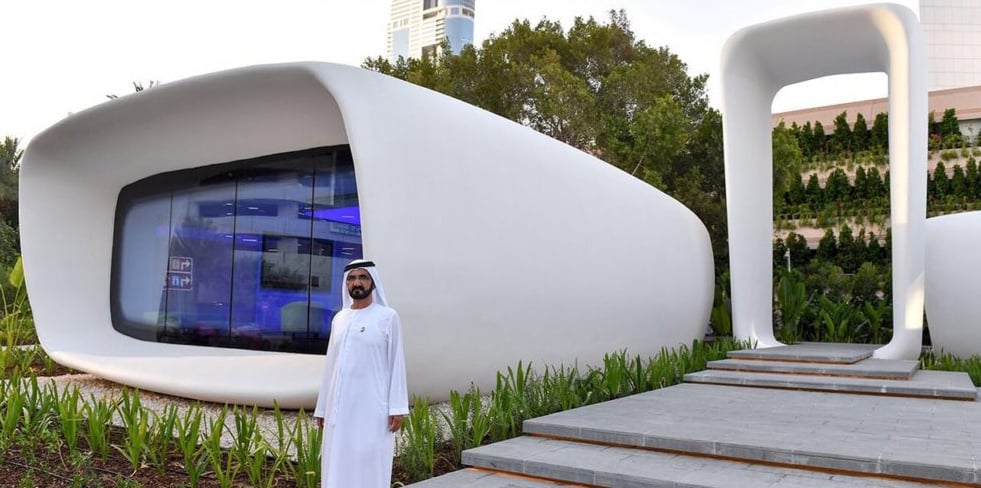
More than Buildings, Concrete Projects Expand
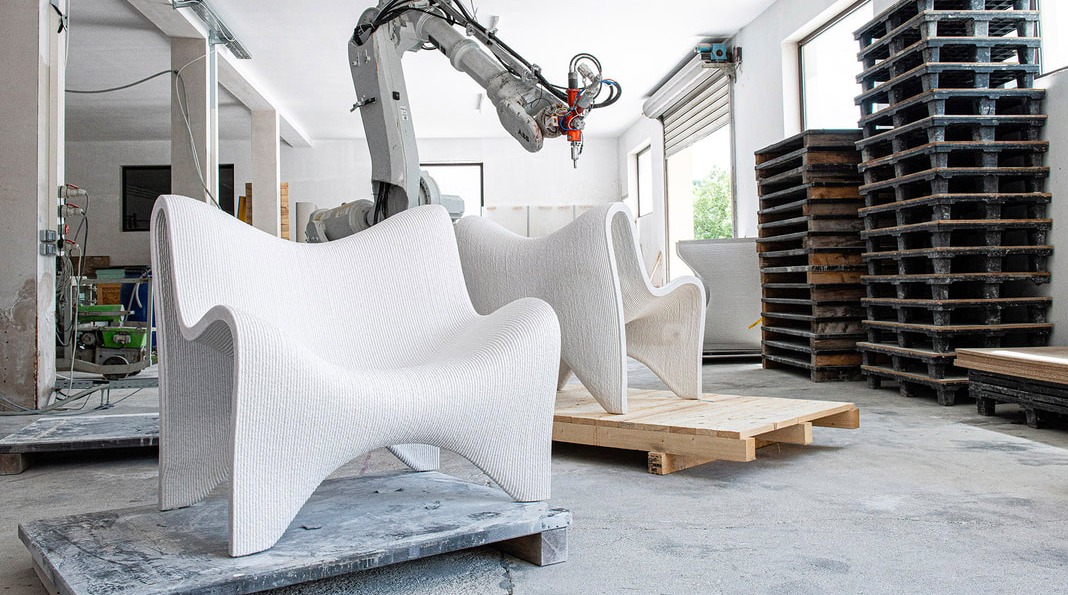
3D concrete printing might still be maturing, but that doesn’t mean the technology hasn’t been successfully put to use in a variety of projects. Families today are living in 3D printed homes, people are working in 3D printed offices, and kids are attending school in 3D printed classrooms. We cover the top and latest projects in our article linked below.
3D printed concrete furniture, garden walls, art, architectural elements, and public works projects are also proving the benefits of the technology.
GUtech, the German Technology University of Oman, in cooperation with construction printer maker Cobod built three buildings in just eight days in Duqm, Oman, in late 2022. Now, the new promising economic zone has a 3D printed coffee shop, a 3D printed public toilet, and a 3D printed Fisherman’s house.
The 871-square-foot coffee shop required a total printing time of 22 hours and material consumption of 19,6 cubic meters of concrete made from 99% locally available raw materials and COBOD’s Dfab solution, developed in cooperation with material maker Cemex.
Another new application for the technology is off-world. NASA has commissioned prototypes of 3D printed habitats for the moon and Mars and recently awarded 3D construction printing company Icon a $57.2 million contract to develop its lunar construction technologies that would use a laser system to melt the moon’s soil to build structures layer by layer.
Icon also completed a 1,700-square-foot simulated Martian habitat for NASA, called Mars Dune Alpha, that astronauts will use for a year-long mission simulation starting in 2023.
3D Printing Concrete for Furniture and Art
3D printing brings out the best in concrete, enabling architects, designers, and artists to stretch the limits of the medium.

Chair N°one has been designed by Studio Oberhauser as part of a pioneering 3D printed concrete chair series, showcasing a unique and futuristic design while using a state-of-the-art high-resolution concrete jetting technology (referred to as selective cement activation). Sustainably printed by using recycled glass as base material, the chairs are 3D printed in one piece, providing structural stability and a continuous, smooth surface. This innovative approach results in a lightweight and highly durable chair, suitable for long-term use in various settings.

Where to Hire a Concrete 3D Printing Builder
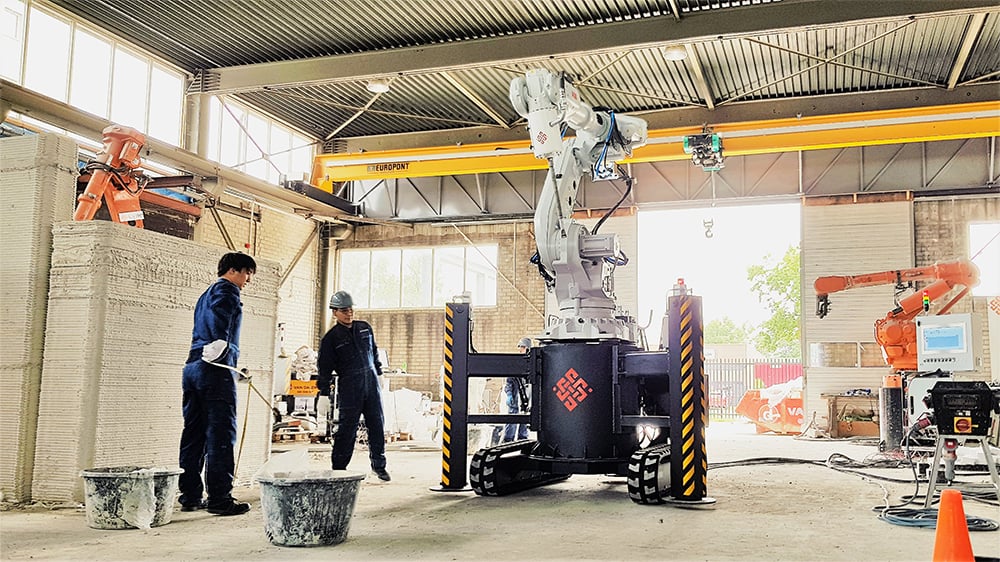
So you want to 3D print a house or building? There are 3D printing systems you can buy, but more common are 3D printing companies you can hire or partner with. Just like traditional home builders, these companies offer a range of services. Even traditional home builders and construction companies today are adding 3D printing to their menu of offerings.
For an updated list of the top companies and the up-in-coming 3D construction printing services, read our guide linked below.
Where to Buy a 3D Concrete Printer

It’s safe to say that the majority of concrete 3d printing in the US today is being done with COBOD 3D printers. The company sells the BOD2 printers that consist of a gantry system with several modules. The number of modules is chosen to fit the specific construction project. The printers start at €180,000 for the smallest model and can cost more than €1 million for a printer capable of constructing a building more than 1,000 square meters on multiple floors.

Florida-based 3D printer maker Apis Cor offers a concrete 3D printer systems consisting of Frank (the printer), Gary (the mixing and pumping unit), and Mary (the material delivery system). Frank is now available to buy worldwide. Unlike a gantry printer, which requires assembly and can require an additional slab apron or concrete footer to be constructed to support the weight of the printer, Frank is a robotic arm 3D printer. It can be moved around the build site and can print up to two stories tall.
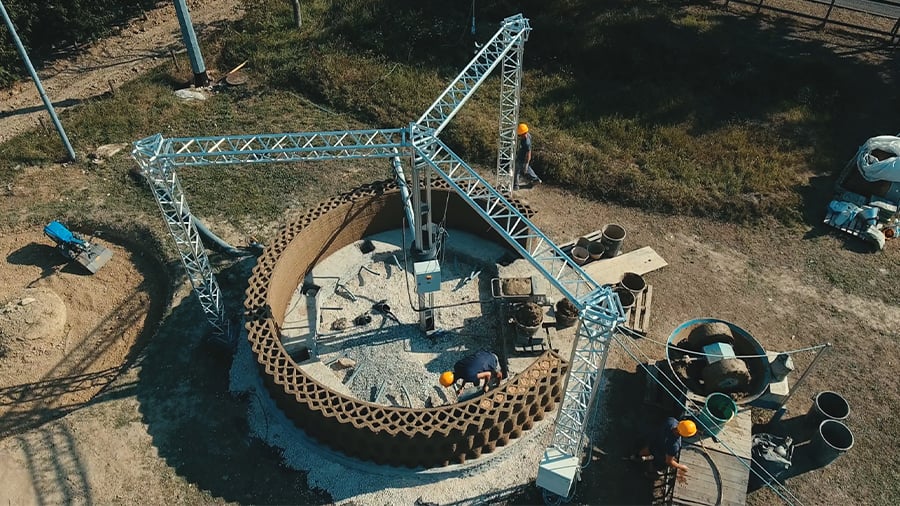
WASP, based in Italy, sells two 3D concrete printers, the 3MT Concrete and the Crane Wasp. The latter is conveniently packed in a shipping container with all the materials you’d need to build a house. The Starter Kit package is designed to build residences using local materials, natural recycled, or standard building materials. The necessary knowledge to set up the Starter Kit is supplied online. The house project, together with its contents, is open source and allows project managers, designers, engineers, and architects, to enter the website and take or exchange contents.
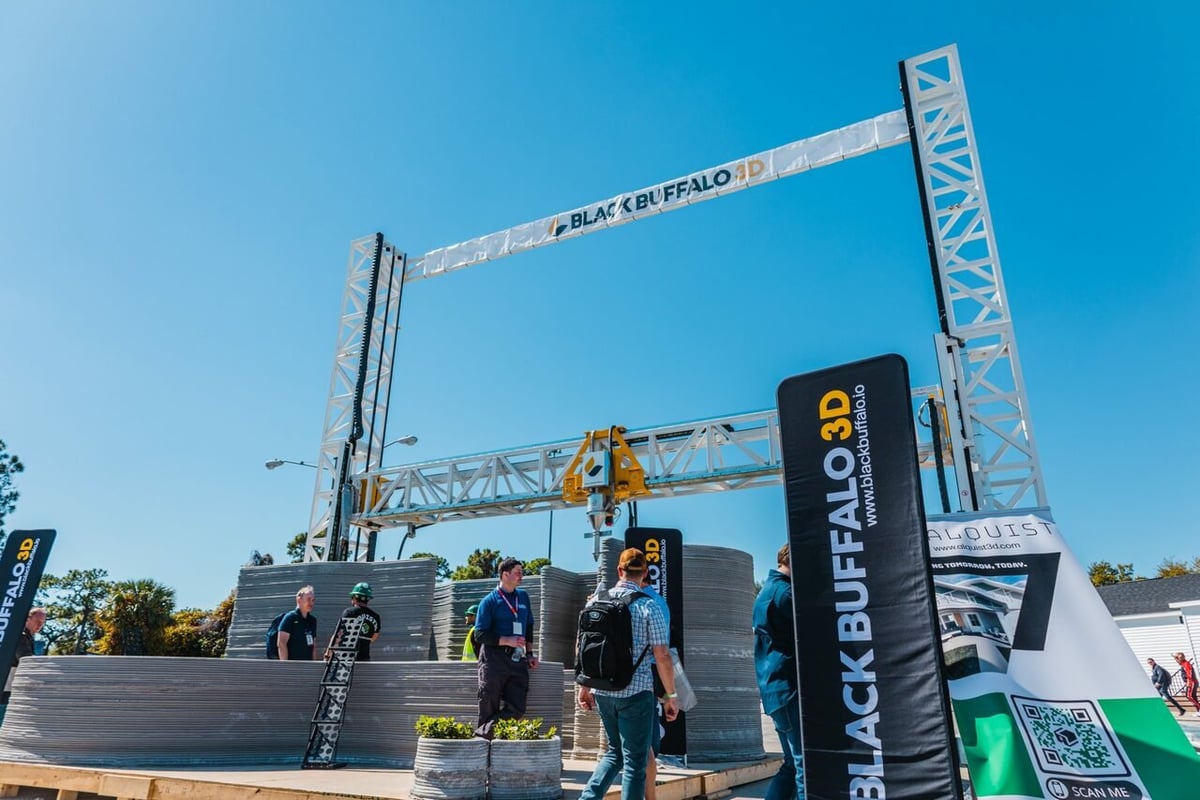
3D, a start-up provider of large-scale 3D printers for construction, offers a line of gantry-based concrete printers called Nexcon. Available to developers, contractors, governments, and NGOs, the printers and materials are designed to save time and money over traditional precast or block methods. The Nexcon multi-axis gantry system is capable of printing structures up to 3 stories high and is optimized to generate accurate prints for any 3D-modelled design that can be created using conventional CAD software. Black Buffalo 3D printers work with the company’s proprietary concrete ink
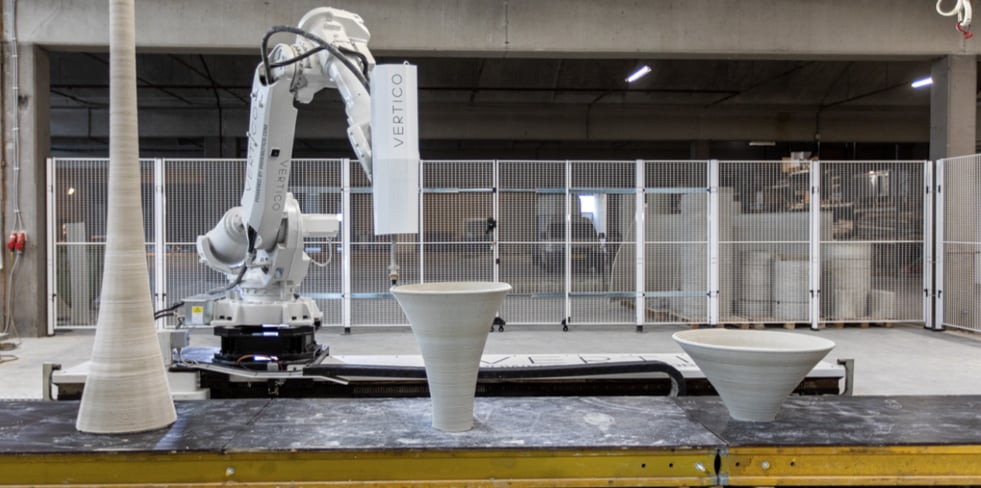
Vertico develops full concrete printing solutions, both with and without accelerated mix at the nozzle. Different robot configurations are possible, from the smallest EVA to the full-track BETA solution.
MudBots is another start-up selling concrete 3D printers in a range of sizes. In addition to dwellings, you can use Mudbots to also make statues, monuments, bridges, and fountains.
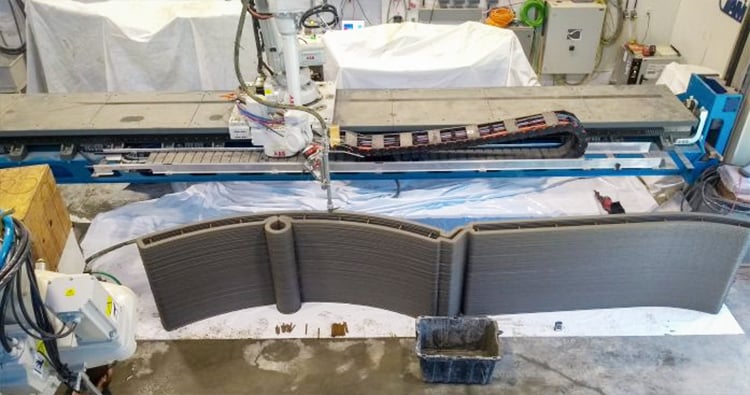
Twente Additive Manufacturing is a Dutch printer manufacturer offering both gantry and robotic arm concrete 3D printers in a range of sizes. The largest, Leonardo model, retails for $1 million.
CyBe, as mentioned in the construction company entry above, offers both printers and construction. Its mobile robotic arm concrete 3D printer starts at $180,000 and its fixed version is €150.
Constructions-3D, a French company, offers a complete turnkey solution for concrete 3D printing on-site for half a million Euros. Transported by container, the kit includes the company’s software and one of the industry’s largest machines.
Lead image source: House from 3D printed concrete by Dutch firm Twente Additive Manufacturing
License: The text of "3D Concrete Printing – The Ultimate Guide" by All3DP Pro is licensed under a Creative Commons Attribution 4.0 International License.


